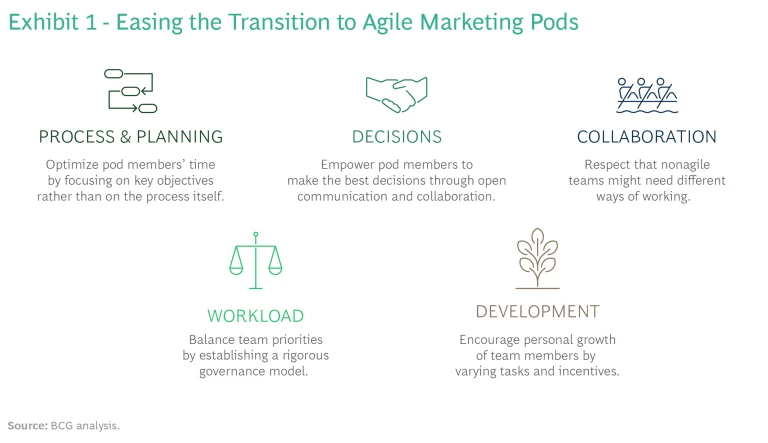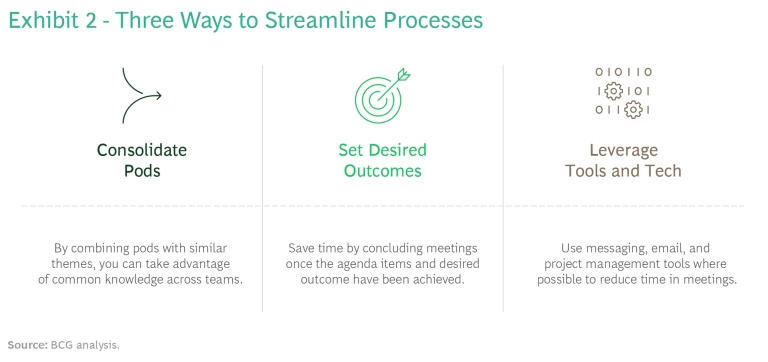Implementing agile marketing pods is a proven way for companies to increase efficiency and collaborative decision making. But marketing organizations that have strict hierarchies or pyramid structures often struggle with implementation, because agile pods by nature cut across organizational reporting lines.
The good news is that organizations have numerous ways to overcome their implementation challenges and achieve the benefits of this new way of working. In this second article in our series on agile marketing organizations, we highlight several recommendations to ease and accelerate the transition to agile marketing pods and away from traditional team structures. (See Exhibit 1.)

Process and Planning: Be Selective, Not Comprehensive
Agile ways of working originated in software development to foster better communication, collaboration, and continuous improvement when firms developed products and applications for customers. Today marketing organizations rely on the same principles to optimize activities such as paid media execution. In the early stages of implementing agile marketing pods, however, they sometimes focus too intently on the official agile methodology. For example, they might include a certain “ceremony” simply because agile prescribes it, even if it may not be worthwhile for the project.
By adopting a few key principles, marketing organizations can capture much of the methodology’s value and impact. Organizations should choose and customize the best combination of agile principles that improve speed to market or cross-functional collaboration. Implementing strict comprehensive programs, in contrast, often creates teams that obsess over doing things right instead of achieving desired outcomes.
If an organization has too many ceremonies, pod members might spend too much time meeting and too little time working.
If an organization has too many ceremonies, pod members might spend too much time meeting and too little time working. Most agile pods run two-week sprints with many meetings to facilitate the process––sprint planning, daily standups, a sprint retrospective, and other agile ceremonies. If one pod member attends all meetings, or is a specialist who gets pulled into multiple pods, it becomes tricky to balance their normal workload with their bandwidth for the pod.

Teams might occasionally need three weeks for a sprint, which means they’ll need to manage their own cadence rather than complying strictly with an agile process. Likewise, a sprint that lasts two weeks and one day is not a process failure if it still meets its objective. The answer often lies in changing and adapting the meeting cadence to give marketing teams the breathing room they need. (See Exhibit 2.) In our experience, organizations can also streamline their processes by:
- Consolidating Pods with Similar Themes: This not only reduces the number of meetings but also facilitates the sharing of common learnings, especially when pods share the same team members anyway.
- Setting a Desired Outcome for Every Meeting: Make sure the agenda and goal of the meeting is clearly communicated with the required attendees. If a meeting completes its agenda and achieves its outcome early, the leader should give any remaining time back to the team members.
- Taking Advantage of Tools and Technology: Instead of live meetings for everyone, the organization could shift some discussions to instant messaging (Slack, Teams) and use emails and Trello boards to keep everyone in sync. Pods can also integrate calendar and project management tools to track workloads efficiently and anticipate bottlenecks.
Decisions: Empower Team Members to Make the Right Choices
Agile teams are self-organizing and cross-functional, meaning that team members are responsible for planning, executing, and delivering work together. But some team members might not feel empowered to take ownership of their work if their roles and responsibilities are unclear, or if there’s a culture of micromanagement, or if team members don’t trust one another. Delays and inefficiencies result if team members do not make decisions or complete tasks in a timely manner.
Teams need to clarify who will sign off on completed work, so that such decisions can enhance time to market rather than impede it. Otherwise the agile pod becomes like a wheel that spins faster but never gains traction.
Marketing organizations therefore should establish clear governance and decision rights. Teams need to clarify who will sign off on completed work, so that such decisions can enhance time to market rather than impede it. Otherwise the agile pod becomes like a wheel that spins faster but never gains traction.
Empowering team members to take ownership of their work increases their motivation, engagement, and productivity, which creates better organizational outcomes. Clear roles and responsibilities foster this culture of empowerment and trust by encouraging collaboration and open communication.
Collaboration: Respectfully Integrate Nonagile Teams
An agile marketing pod focused on its own work can lose sight of the fact that partners, agencies, and vendors might not work with agile principles. External agencies may require lead times of several weeks, making their work routines incompatible with a two-week sprint.
This may even hold true for internal specialists––such as colleagues from legal or procurement who have the expertise to solve a particular problem––who aren’t accustomed to the pace, expectations, and intense results orientation that agile processes can exert. When an agile team cannot mesh smoothly with nonagile teams, projects lose momentum because the organization is grinding its gears.
Better communication across teams, especially regarding lead times, addresses this challenge. Give advance notice about deadlines so nonagile teams can prepare some work at their own pace and then integrate with the agile team in a “just-in-time” way to complete a project. Having representatives from external agencies or internal departments attend sprint meetings can help them set priorities and adjust their resources accordingly.
Over time, however, the nonagile teams will need to adjust to the speed and intensity of agile principles. Marketing organizations need to communicate that expectation and eventually make fewer accommodations to alternative working models.
Workload: Adjust Priorities as Projects Progress
The reward for good work is more work, as the saying goes. But when the workload expands faster than capacity, it can threaten the gains in quality and efficiency.
The answer lies in adjusting the team’s priorities. The organization should have a rigorous governance model in place to prioritize work based on the investment level, value, and ease of execution. A core team representing brand, media, and creative should review priorities regularly and redirect the team’s effort if needed. This process will be ongoing, because if the agile pods are working the way they should, the amount of work the organization takes on will always grow.
By tracking progress and knowing who is working on what projects, the organization can assess team capacities, identify bottlenecks, and respond quickly with a reallocation of resources.
The organization also should have a system that provides an overview of all active projects at any given time. By tracking progress and knowing who is working on what projects, the organization can assess team capacities, identify bottlenecks, and respond quickly with a reallocation of resources. This can include the strategic outsourcing of some work.
Personal Development: Vary Tasks and Incentives to Prevent Burnout
The corollary to that old saying about the reward for good work is that a team gets more of the same work. It seems logical for the organization to double down on a team’s unique strengths to drive greater efficiency and even better performance.
Over time, that can lead to burnout. At best, team members drift into a sleepy comfort zone, surrounded by familiar colleagues doing work that’s no longer challenging. At worst, individuals or whole teams become deeply dissatisfied. They are not only doing nothing new, but also learning nothing new. Eventually they feel detached from the larger objectives and vision of the pod and the company.
Marketing organizations should treat learning and development as priorities, not options, by varying tasks and incentives.
Marketing organizations should treat learning and development as priorities, not options, by varying tasks and incentives. Having team members focus on a different customer segment, product line, or channel enriches their work, builds skills, and keeps the work challenging. Changing the composition of teams can accomplish the same effect, though to a lesser degree. We have found that organizations with agile marketing pods should shift the team members around every six-to-twelve months. To incentivize the right behaviors, organizations should evaluate and reward teams not only on the volume and quality of their work, but also on its breadth and on how well team members empowered each other to improve together.
The rewards for good work should extend beyond giving the team members more work. Organizations can send people to trainings or offer attendance at an industry conference or convention as a prize. Public praise, the sharing of experiences, and extra time off are also welcome rewards.
Agile pods enable a marketing organization to execute effectively and efficiently while responding in a dynamic way to the changing market landscape. The ultimate goal, of course, is operating the entire marketing organization in an agile way. Making agile stick requires an investment in both time and resources as well as patience and tolerance along the learning curve.
The rewards of implementing agile pods in a balanced way are ample for marketing organizations, in terms of both process and market impact. On the process side, companies will notice less friction, better team rapport, and a new ability of team members to learn and apply new skills. Likewise, performance improves and ROI increases because the teams can run more targeted and personalized communications more often.


